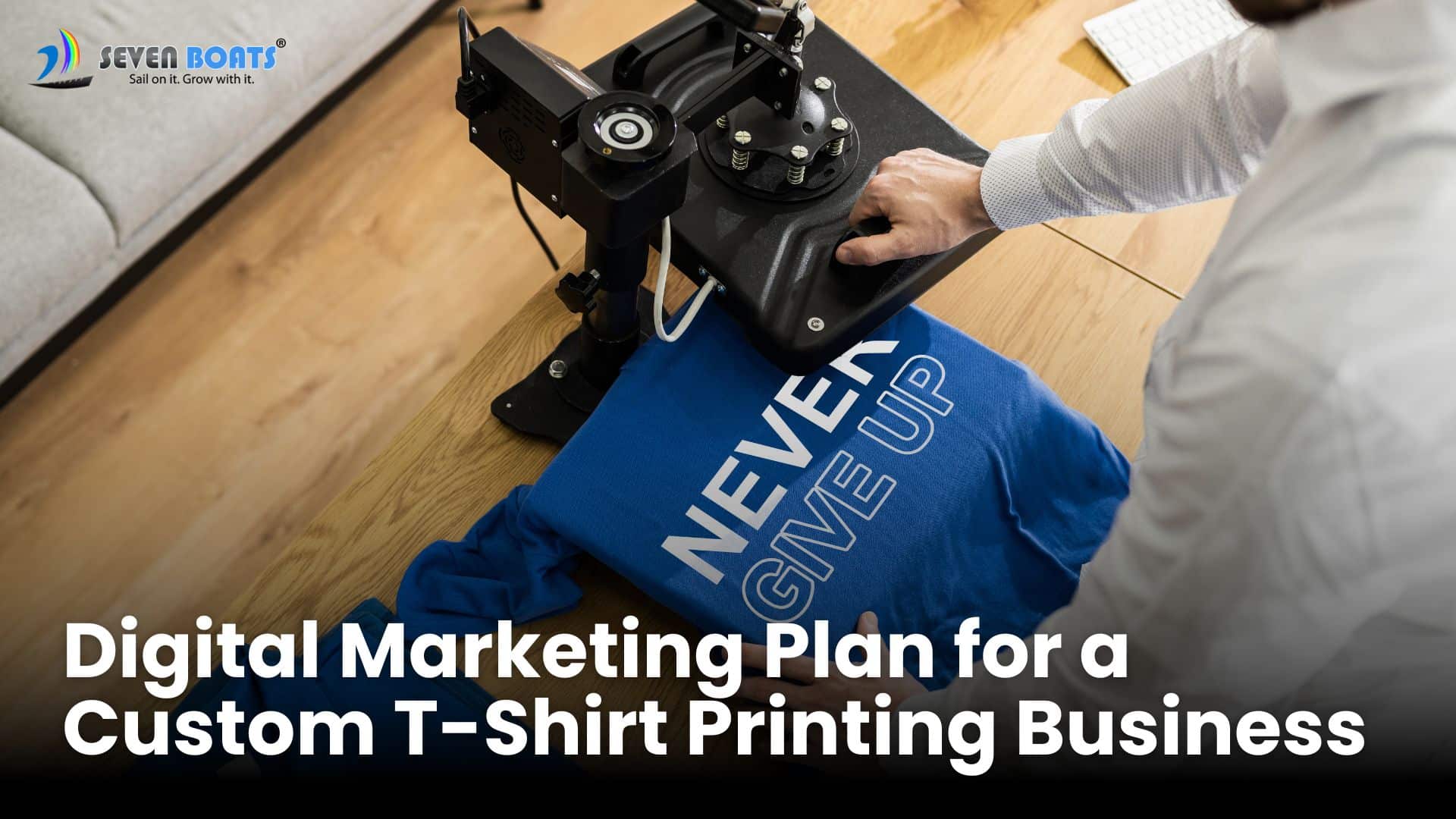Digital marketing is essential for any business aiming to succeed in today’s competitive market. For a custom T-shirt printing business, it’s important to stand out and effectively reach your target audience. This blog will provide a comprehensive digital marketing plan tailored to a custom T-shirt printing business. We’ll cover everything from identifying your target market to leveraging social media, email marketing, SEO, and paid advertising.
Understanding Your Market
Identifying Your Target Audience
The first step in any marketing plan is understanding who you are marketing to. For a custom T-shirt printing business, your target audience could include:
- Individuals: People looking for personalized T-shirts for special occasions, gifts, or personal use.
- Businesses: Companies needing custom T-shirts for branding, uniforms, or promotional events.
- Organizations and Clubs: Schools, sports teams, clubs, and non-profits requiring T-shirts for members or events.
Conducting Market Research
Market research helps you understand the needs and preferences of your target audience. Here are some methods:
- Surveys and Questionnaires: Gather feedback from potential customers.
- Focus Groups: Engage in detailed discussions with a small group of your target audience.
- Competitor Analysis: Study what your competitors are doing and identify gaps in the market.
Creating Buyer Personas
Buyer personas are detailed profiles of your ideal customers. Include the following in each persona:
- Demographics: Age, gender, income, location.
- Psychographics: Interests, values, lifestyle.
- Behavior: Buying habits, brand loyalty, online activity.
Building Your Brand
Defining Your Brand Identity
Your brand identity is how you want your business to be perceived. It includes your business name, logo, color scheme, and overall aesthetic. Make sure it reflects your values and appeals to your target audience.
Crafting Your Brand Message
Your brand message should communicate what makes your business unique. This could be:
- Quality: High-quality materials and printing techniques.
- Customization: A wide range of customization options.
- Customer Service: Exceptional customer service and support.
Creating a Memorable Logo
A memorable logo helps establish your brand identity. Ensure it:
- Reflects Your Brand: Aligns with your brand message and identity.
- Is Simple and Scalable: Easy to recognize and works well in different sizes.
- Has a Strong Color Scheme: Uses colors that evoke the right emotions and stand out.
Developing a Website
Choosing a Platform
Select a website platform that suits your needs. Some popular options include:
- Shopify: Great for e-commerce with built-in tools.
- WordPress with WooCommerce: Highly customizable with many plugins.
- Squarespace: User-friendly with beautiful templates.
Designing Your Website
Your website should be user-friendly and visually appealing. Key elements include:
- Homepage: Clear navigation, eye-catching images, and a strong call to action.
- Product Pages: Detailed descriptions, high-quality images, and easy-to-use customization tools.
- About Page: Information about your business, values, and team.
- Contact Page: Easy ways for customers to reach you.
Optimizing for Mobile
Ensure your website is mobile-friendly, as many customers will browse and shop from their phones. Key points:
- Responsive Design: Adapts to different screen sizes.
- Fast Load Times: Mobile users expect quick access.
- Easy Navigation: Simple menus and buttons that are easy to tap.
Content Marketing
Creating Valuable Content
Content marketing involves creating valuable, relevant content to attract and engage your audience. Ideas include:
- Blog Posts: Tips on custom T-shirt design, fashion trends, and care instructions.
- How-To Guides: Step-by-step guides for creating custom designs.
- Customer Stories: Showcase customer experiences and testimonials.
Using Visual Content
Visual content is particularly effective for a custom T-shirt business. Consider:
- Photos: High-quality images of your products.
- Videos: Tutorials, behind-the-scenes looks, and customer testimonials.
- Infographics: Visual guides on T-shirt styles, sizes, and customization options.
Developing a Content Calendar
A content calendar helps you plan and organize your content. Include:
- Topics: List of content ideas.
- Formats: Types of content (blog posts, videos, etc.).
- Publishing Schedule: When and where each piece of content will be published.
Social Media Marketing
Choosing the Right Platforms
Focus on platforms where your target audience is most active. Popular choices include:
- Facebook: Wide user base, good for ads and community building.
- Instagram: Visual platform ideal for showcasing T-shirts.
- Pinterest: Great for visual inspiration and driving traffic to your website.
- TikTok: Engages a younger audience with short, creative videos.
Creating Engaging Content
Tailor your content to each platform. Ideas include:
- Behind-the-Scenes: Show the T-shirt printing process.
- User-Generated Content: Share photos and videos from customers.
- Contests and Giveaways: Encourage followers to engage with your brand.
Using Hashtags and Trends
Leverage hashtags and trends to increase your reach. Tips:
- Relevant Hashtags: Use popular and niche hashtags related to T-shirts and customization.
- Trending Topics: Create content around current events, holidays, and viral trends.
Engaging with Your Audience
Engagement is key to building a loyal following. Strategies include:
- Responding to Comments and Messages: Show appreciation and address inquiries.
- Running Polls and Q&A Sessions: Encourage interaction and gather feedback.
- Collaborating with Influencers: Partner with influencers to reach a wider audience.
Email Marketing
Building an Email List
Start by collecting email addresses from customers and website visitors. Methods include:
- Sign-Up Forms: Place forms on your website, especially on the homepage and checkout page.
- Offers and Discounts: Encourage sign-ups with exclusive offers.
- Contests and Giveaways: Collect emails as part of entry requirements.
Crafting Effective Emails
Create emails that provide value to your subscribers. Types of emails:
- Welcome Series: Introduce new subscribers to your brand and offerings.
- Promotional Emails: Highlight special offers, new products, and sales.
- Educational Content: Share tips, guides, and behind-the-scenes content.
- Newsletters: Regular updates with a mix of content.
Personalizing Your Emails
Personalization can significantly improve engagement. Techniques include:
- Segmenting Your List: Group subscribers based on their interests and behaviors.
- Using Names: Address subscribers by their first names.
- Tailoring Content: Send relevant offers and content based on subscriber preferences.
Analyzing Email Performance
Track key metrics to measure the effectiveness of your email campaigns. Important metrics:
- Open Rates: Percentage of recipients who open your emails.
- Click-Through Rates: Percentage of recipients who click on links in your emails.
- Conversion Rates: Percentage of recipients who make a purchase after clicking a link.
Search Engine Optimization (SEO)
Conducting Keyword Research
Identify keywords that your target audience is searching for. Tools include:
- Google Keyword Planner: Find relevant keywords and see their search volume.
- Ahrefs: Explore keyword ideas and analyze competitors.
- Ubersuggest: Discover keyword opportunities and trends.
Optimizing On-Page SEO
Improve your website’s visibility on search engines. Key elements:
- Title Tags and Meta Descriptions: Include target keywords and create compelling descriptions.
- Header Tags: Use H1, H2, and H3 tags to structure your content.
- Alt Text for Images: Describe your images with relevant keywords.
- Internal Linking: Link to other relevant pages on your website.
Creating High-Quality Content
Google favors websites with valuable content. Tips for creating SEO-friendly content:
- In-Depth Articles: Provide comprehensive information on relevant topics.
- Engaging Writing: Keep your audience interested with clear, engaging language.
- Regular Updates: Keep your content fresh and up-to-date.
Building Backlinks
Backlinks from reputable websites can boost your SEO. Strategies include:
- Guest Blogging: Write articles for other blogs in your industry.
- Collaborations: Partner with influencers and other businesses for mutual promotion.
- Press Releases: Share newsworthy updates with media outlets.
Paid Advertising
Setting Up Google Ads
Google Ads can drive targeted traffic to your website. Key steps:
- Keyword Research: Choose relevant keywords for your ads.
- Creating Ads: Write compelling ad copy and design eye-catching visuals.
- Setting Budgets: Determine how much you’re willing to spend on each campaign.
- Tracking Performance: Use Google Analytics to monitor and optimize your ads.
Leveraging Social Media Ads
Social media platforms offer powerful advertising options. Tips for success:
- Defining Your Audience: Use targeting options to reach your ideal customers.
- Creating Visual Ads: Use high-quality images and videos.
- Running A/B Tests: Test different ad creatives and targeting options.
- Monitoring Results: Track metrics like impressions, clicks, and conversions.
Retargeting Campaigns
Retargeting helps you reach people who have previously visited your website. Steps to set up retargeting:
- Install Tracking Pixels: Add tracking pixels from platforms like Facebook and Google to your website.
- Segment Your Audience: Create segments based on user behavior (e.g., visited product pages, abandoned carts).
- Create Retargeting Ads: Design ads that remind visitors of your products and encourage them to return.
Analyzing and Adjusting Your Strategy
Using Analytics Tools
Regularly analyze your marketing efforts to see what’s working and what needs improvement. Key tools:
- Google Analytics: Track website traffic, user behavior, and conversions.
- Social Media Insights: Monitor engagement and reach on social media platforms.
- Email Marketing Analytics: Measure open rates, click-through rates, and conversions.
Setting and Tracking KPIs
Key performance indicators (KPIs) help you measure success. Important KPIs include:
- Website Traffic: Number of visitors to your site.
- Conversion Rate: Percentage of visitors who make a purchase.
- Customer Acquisition Cost (CAC): Cost to acquire a new customer.
- Customer Lifetime Value (CLV): Total revenue from a customer over their lifetime.
Adjusting Your Strategy
Based on your analysis, adjust your strategy to improve results. Actions might include:
- Optimizing Underperforming Channels: Focus on areas that need improvement.
- Doubling Down on Success: Invest more in channels that are performing well.
- Testing New Ideas: Continuously test new tactics and strategies.
Building a Community
Creating a Loyal Customer Base
Building a loyal customer base is key to long-term success. Strategies include:
- Exceptional Customer Service: Go above and beyond to satisfy customers.
- Loyalty Programs: Reward repeat customers with discounts and special offers.
- Personal Touches: Send personalized thank-you notes or small gifts.
Engaging with Your Community
Engage with your community to build strong relationships. Ideas include:
- Hosting Events: Organize events like design contests or community meet-ups.
- Social Media Interaction: Regularly engage with followers on social media.
- User-Generated Content: Encourage customers to share photos and stories.
Encouraging Word-of-Mouth Marketing
Happy customers are your best marketers. Encourage word-of-mouth marketing by:
- Referral Programs: Offer incentives for customers who refer friends.
- Testimonials and Reviews: Ask satisfied customers to leave reviews.
- Social Proof: Share customer stories and testimonials on your website and social media.
Conclusion
Creating a comprehensive digital marketing plan for your custom T-shirt printing business involves understanding your market, building a strong brand, developing an effective website, leveraging various marketing channels, and continually analyzing and adjusting your strategy. By following the steps outlined in this guide, you’ll be well on your way to reaching your target audience, building a loyal customer base, and growing your business.
However, executing this plan can be time-consuming and complex. Partnering with a digital marketing agency can provide you with the expertise and resources needed to manage and optimize your digital marketing efforts effectively. A digital marketing agency can help you implement advanced strategies, run targeted advertising campaigns, and analyze performance metrics, allowing you to focus on what you do best – creating high-quality custom T-shirts.
Remember, the key to success in digital marketing is consistency, creativity, and a deep understanding of your customers’ needs and preferences. Happy marketing!








This is a comprehensive guide to digital marketing for custom t-shirt printing businesses! It covers a wide range of strategies, from social media and email marketing to SEO and influencer marketing.
“Drive sales for your custom t-shirt printing business with a digital marketing plan that includes targeted ads, social media campaigns, influencer partnerships, and a user-friendly e-commerce site.”
Thanks for sharing an informative blog
This is an excellent guide for creating a digital marketing plan for a custom t-shirt printing business! The focus on social media marketing, personalized ads, and influencer collaborations is spot-on for reaching the right audience. Custom t-shirts thrive on creativity, and your tips on showcasing unique designs and engaging customers online will definitely help boost sales. Thanks for sharing these valuable insights!
I am very excited to read your Digital Marketing Plan for a Custom T-Shirt Printing Business blog. I agree with your words 100%. I think every word you said in the blog is logical and very important. Especially you have discussed digital marketing from beginning to end in detail. For example: Digital Marketing Plan for a Custom T-Shirt Printing Business, Social Media Marketing, Email Marketing, Search Engine Optimization (SEO), Paid Advertising etc. You have described it in detail and very beautifully. I think such a beautiful and detailed discussion on digital marketing is possible only by an experienced person. I am writing about digital marketing. Maybe I can’t write as well as you, but I try to write well. Thank you
I love your Blog Post. This is informative